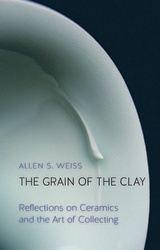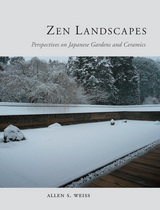3 books about Weiss, Allen S.

The Grain of the Clay
Reflections on Ceramics and the Art of Collecting
Allen S. Weiss
Reaktion Books, 2016
Ceramics give pleasure to our everyday lives, from the beauty of a vase’s elegant curves to the joy of a meal served upon a fine platter. Ceramics originate in a direct engagement with the earth and maintain a unique place in the history of the arts. In this book, Allen S. Weiss sharpens our perception of and increases our appreciation for ceramics, all the while providing a critical examination of how and why we collect them.
Weiss examines the vast stylistic range of ceramics and investigates both the theoretical and personal reasons for viewing, using, and collecting them. Relating ceramics to other arts and practices—especially those surrounding food—he explores their different uses such as in the celebrated tea ceremony of Japan. Most notably, he considers how works previously viewed as crafts have found their rightful way into museums, as well as how this new-found engagement with finely wrought natural materials may foster an increased ecological sensitivity. The result is a wide-ranging and sensitive look at a crucial part of our material culture.
Weiss examines the vast stylistic range of ceramics and investigates both the theoretical and personal reasons for viewing, using, and collecting them. Relating ceramics to other arts and practices—especially those surrounding food—he explores their different uses such as in the celebrated tea ceremony of Japan. Most notably, he considers how works previously viewed as crafts have found their rightful way into museums, as well as how this new-found engagement with finely wrought natural materials may foster an increased ecological sensitivity. The result is a wide-ranging and sensitive look at a crucial part of our material culture.
[more]

Phantasmic Radio
Allen S. Weiss
Duke University Press, 1995
The alienation of the self, the annihilation of the body, the fracturing, dispersal, and reconstruction of the disembodied voice: the themes of modernism, even of modern consciousness, occur as a matter of course in the phantasmic realm of radio. In this original work of cultural criticism, Allen S. Weiss explores the meaning of radio to the modern imagination. Weaving together cultural and technological history, aesthetic analysis, and epistemological reflection, his investigation reveals how radiophony transforms expression and, in doing so, calls into question assumptions about language and being, body and voice.
Phantasmic Radio presents a new perspective on the avant-garde radio experiments of Antonin Artaud and John Cage, and brings to light fascinating, lesser-known work by, among others, Valère Novarina, Gregory Whitehead, and Christof Migone. Weiss shows how Artaud’s "body without organs" establishes the closure of the flesh after the death of God; how Cage’s "imaginary landscapes" proffer the indissociability of techne and psyche; how Novarina reinvents the body through the word in his "theater of the ears." Going beyond the art historical context of these experiments, Weiss describes how, with their emphasis on montage and networks of transmission, they marked out the coordinates of modernism and prefigured what we now recognize as the postmodern.
Phantasmic Radio presents a new perspective on the avant-garde radio experiments of Antonin Artaud and John Cage, and brings to light fascinating, lesser-known work by, among others, Valère Novarina, Gregory Whitehead, and Christof Migone. Weiss shows how Artaud’s "body without organs" establishes the closure of the flesh after the death of God; how Cage’s "imaginary landscapes" proffer the indissociability of techne and psyche; how Novarina reinvents the body through the word in his "theater of the ears." Going beyond the art historical context of these experiments, Weiss describes how, with their emphasis on montage and networks of transmission, they marked out the coordinates of modernism and prefigured what we now recognize as the postmodern.
[more]

Zen Landscapes
Perspectives on Japanese Gardens and Ceramics
Allen S. Weiss
Reaktion Books, 2013
The essential elements of a dry Japanese garden are few: rocks, gravel, moss. Simultaneously a sensual matrix, a symbolic form, and a memory theater, these gardens exhibit beautiful miniaturization and precise craftsmanship. But their apparent minimalism belies a true complexity. In Zen Landscapes, Allen S. Weiss takes readers on an exciting journey through these exquisite sites, explaining how Japanese gardens must be approached according to the play of scale, surroundings, and seasons, as well as in relation to other arts—revealing them as living landscapes rather than abstract designs.
Weiss shows that these gardens are inspired by the Zen aesthetics of the tea ceremony, manifested in poetry, painting, calligraphy, architecture, cuisine, and ceramics. Japanese art favors suggestion and allusion, valuing the threshold between the distinct and the inchoate, between figuration and abstraction, and he argues that ceramics play a crucial role here, relating as much to the site-specificity of landscape as to the ritualized codes of the tea ceremony and the everyday gestures of the culinary table.
With more than one hundred stunning color photographs, Zen Landscapes is the first in-depth study in the West to examine the correspondences between gardens and ceramics. A fascinating look at landscape art and its relation to the customs and craftsmanship of the Japanese arts, it will appeal to readers interested in landscape design and Japan’s art and culture.
[more]
READERS
Browse our collection.
PUBLISHERS
See BiblioVault's publisher services.
STUDENT SERVICES
Files for college accessibility offices.
UChicago Accessibility Resources
home | accessibility | search | about | contact us
BiblioVault ® 2001 - 2024
The University of Chicago Press









